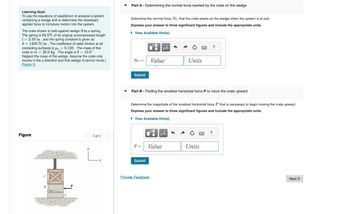
Elements Of Electromagnetics
7th Edition
ISBN: 9780190698614
Author: Sadiku, Matthew N. O.
Publisher: Oxford University Press
expand_more
expand_more
format_list_bulleted
Question
Help!!! Answer it correctly!!! Please

Transcribed Image Text:Learning Goal:
To use the equations of equilibrium to analyze a system
containing a wedge and to determine the necessary
applied force to introduce motion into the system.
The crate shown is held against wedge B by a spring.
The spring is 94.5% of its original uncompressed length
12.50 m, and the spring constant is given as
k=1450 N/m. The coefficient of static friction at all
contacting surfaces is μ, = 0.120. The mass of the
crate is m 28.0 kg. The angle is 0=10.0°.
Neglect the mass of the wedge. Assume the crate only
moves in the y direction and that wedge A cannot move.(
Figure 1)
Part A - Determining the normal force exerted by the crate on the wedge
Determine the normal force No that the crate exerts on the wedge when the system is at rest.
Express your answer to three significant figures and include the appropriate units.
▸ View Available Hint(s)
?
Nc = Value
Units
Submit
Part B - Finding the smallest horizontal force P to move the crate upward
Determine the magnitude of the smallest horizontal force P that is necessary to begin moving the crate upward.
Express your answer to three significant figures and include the appropriate units.
▸ View Available Hint(s)
Figure
1 of 1
P = Value
Units
་
Submit
Provide Feedback
?
Next >
Expert Solution
This question has been solved!
Explore an expertly crafted, step-by-step solution for a thorough understanding of key concepts.
Step by stepSolved in 2 steps with 2 images

Knowledge Booster
Similar questions
- The two gears in the picture below on the left are meshing together. The two gears in the picture on the right are stuck together and are on the same shaft. Which of these statements is true when the gears are turning? (There may be more than one correct answer). A. The two meshing gears have the same |?| B. The two gears on the same shaft have the same |?| C. The two meshing gears turn through the same magnitude of arc-length in the same time D. The two gears on the same shaft turn through the same magnitude of arc-length in the same timearrow_forwardBasic Conversions A solid flat disk is rotating in the counter-clockwise (or positive) direction. There is an object (small black dot) on the disk, rotating with the disk. The object is a distance 1.30 meters from the axis of rotation (the center of the disk). It had an angular velocity of 4.00 radians / second at the initial position of 0 Radians (see black line on image). After 1.57 seconds, it has an angular velocity of 7.00 radians / second at the position shown in the picture. O Radians What is the tangential linear acceleration as it has moved from the 0 position to the current position? Your answer should have the following: 2 Decimal Places Correct SI Units Appropriate Signs for Vector quantity answers Answers must be in the following format: Written out and NOT in scientific notation Acceptable: 278.40 Not Acceptable: 2.784 x 102 Your Answer: Answer unitsarrow_forwardSystem for shorter flight times With his invention, Håkan Lans has made it possible to shorten flight times. Thanks to his invention, a pilot can see the exact positions of other aircraft. ( what is the right answer? Registered design Logo Patent d. Copyrightarrow_forward
- - once answered correctly will UPVOTE!!arrow_forwardHow did you find the formula of sin tetaarrow_forwardb) You are given a set of six links. The lengths of the links are as follows: 6.3cm, 9.1cm,12.4cm,15.6cm,20cm,40.2cmSketch a crank-rocker mechanism you can realize using a selection of four links from the set.arrow_forward
arrow_back_ios
arrow_forward_ios
Recommended textbooks for you
 Elements Of ElectromagneticsMechanical EngineeringISBN:9780190698614Author:Sadiku, Matthew N. O.Publisher:Oxford University Press
Elements Of ElectromagneticsMechanical EngineeringISBN:9780190698614Author:Sadiku, Matthew N. O.Publisher:Oxford University Press Mechanics of Materials (10th Edition)Mechanical EngineeringISBN:9780134319650Author:Russell C. HibbelerPublisher:PEARSON
Mechanics of Materials (10th Edition)Mechanical EngineeringISBN:9780134319650Author:Russell C. HibbelerPublisher:PEARSON Thermodynamics: An Engineering ApproachMechanical EngineeringISBN:9781259822674Author:Yunus A. Cengel Dr., Michael A. BolesPublisher:McGraw-Hill Education
Thermodynamics: An Engineering ApproachMechanical EngineeringISBN:9781259822674Author:Yunus A. Cengel Dr., Michael A. BolesPublisher:McGraw-Hill Education Control Systems EngineeringMechanical EngineeringISBN:9781118170519Author:Norman S. NisePublisher:WILEY
Control Systems EngineeringMechanical EngineeringISBN:9781118170519Author:Norman S. NisePublisher:WILEY Mechanics of Materials (MindTap Course List)Mechanical EngineeringISBN:9781337093347Author:Barry J. Goodno, James M. GerePublisher:Cengage Learning
Mechanics of Materials (MindTap Course List)Mechanical EngineeringISBN:9781337093347Author:Barry J. Goodno, James M. GerePublisher:Cengage Learning Engineering Mechanics: StaticsMechanical EngineeringISBN:9781118807330Author:James L. Meriam, L. G. Kraige, J. N. BoltonPublisher:WILEY
Engineering Mechanics: StaticsMechanical EngineeringISBN:9781118807330Author:James L. Meriam, L. G. Kraige, J. N. BoltonPublisher:WILEY

Elements Of Electromagnetics
Mechanical Engineering
ISBN:9780190698614
Author:Sadiku, Matthew N. O.
Publisher:Oxford University Press

Mechanics of Materials (10th Edition)
Mechanical Engineering
ISBN:9780134319650
Author:Russell C. Hibbeler
Publisher:PEARSON

Thermodynamics: An Engineering Approach
Mechanical Engineering
ISBN:9781259822674
Author:Yunus A. Cengel Dr., Michael A. Boles
Publisher:McGraw-Hill Education

Control Systems Engineering
Mechanical Engineering
ISBN:9781118170519
Author:Norman S. Nise
Publisher:WILEY

Mechanics of Materials (MindTap Course List)
Mechanical Engineering
ISBN:9781337093347
Author:Barry J. Goodno, James M. Gere
Publisher:Cengage Learning

Engineering Mechanics: Statics
Mechanical Engineering
ISBN:9781118807330
Author:James L. Meriam, L. G. Kraige, J. N. Bolton
Publisher:WILEY